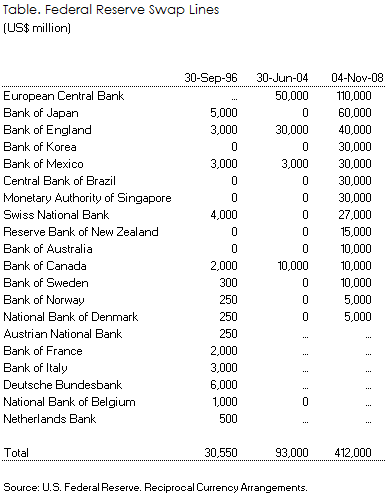U.S. Federal Reserve swap lines
10 November 2008
Ousmène Jacques Mandeng, Ashmore Investment Management
The U.S. Federal Reserves has extended swap lines to several central banks including to Brazil, Singapore and Korea.1 The Fed swap network has been in place for decades but its revival has been the clearest indication yet that the Fed is concerned about global dollar liquidity and its potentially disruptive effect for the global financial system.
The Fed swap lines can be traced back at least to 1967 when a line was established for Mexico to help deal with “balance of payment issues and specifically to help support the then-fixed exchange rate between the peso and the dollar”.2 The Fed also maintained several arrangements with G10 central banks and the Bank of International Settlement (BIS). In 1998, most of those facilities were allowed to lapse by mutual agreement and almost never drawn upon and only the lines with the Bank of Canada and the Bank of Mexico were maintained. Temporary reciprocal currency arrangements for 30 days were extended in September 2001 to the ECB and the Bank of England with an augmentation for the Bank of Canada. The ECB used US$23.5 billion on September 12-14, 2001 (Table).
Mexico’s swap line was key during the 1994/95 Mexico crisis. On December 19, 1994, when Mexico was forced to devalue the peso, it had access to a US$3 billion swap line from the Fed. The line was augmented to US$4.5 billion on December 30, 1994. Resources were also provided under the U.S. treasury exchange stabilisation fund (ESF) and swap lines with the Bank of Canada, commercial banks and the BIS. By January 13, 1995, Mexico had used US$500 million from the Fed, US$500 million from the ESF and Can$166 million from the Bank of Canada.
Today swap lines to emerging markets are most probably not aimed at addressing immediate liquidity concerns amid continuous high levels of international reserves. The swap lines should be seen as a strong signal about monetary cooperation. The significant increase in the swap lines to levels well in excess to those extended in September 2001, marks the qualitative shift in the concern for global dollar liquidity and consequences thereof. The swap lines also raise new questions: Why does a country like Brazil and Korea with US$205 and US$212 billion in international reserves need US$30 billion in swap lines? Will there be greater credit differentiation with regard to countries without a Fed swap line? Critical observers may argue on the former that the Fed may want to prevent undue selling pressures of U.S. treasury securities and on the latter that non-Fed-qualifying countries can no longer be trusted on a stand-alone basis.
In 1994, when the Fed deliberated about whether to extend the existing swap line for Mexico, politics were clearly a part. The FOMC transcript reads that “if we decide to disengage, we will lose whatever power in that area we have to influence the system […]” (Chairman Greenspan).3 As before political considerations are also at play but the ambitions seem far broader and consequential in scope. The Fed has signalled that it cares greatly about the dollar being used in an orderly fashion to settle international transactions. As such it seems set to prolong the dollar as the preeminent anchor of the international financial system. It may also lead to the perception though that an elastic supply of dollars may ultimately meet an elastic demand.

1 A swap transaction involves both a spot (immediate delivery) transaction, in which the Federal Reserve transfers dollars to another central bank in ex- change for foreign currency, and a simultaneous forward (future delivery) trans action, in which the two central banks agree to reverse the spot transaction (Federal Reserve, Purposes and Functions, June 2005).
2 Transcript of FOMC Meeting of March 22, 1994.
3 Transcript of FOMC Meeting of March 22, 1994.